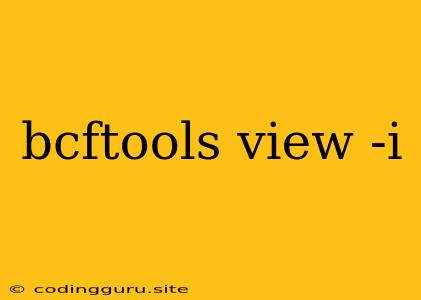Unveiling the Power of bcftools view -i
In the realm of bioinformatics, variant calling and analysis play a crucial role in understanding the intricacies of genetic variation. bcftools emerges as a versatile and indispensable tool within this landscape, empowering researchers to manipulate and analyze variant data stored in VCF (Variant Call Format) files. Among its diverse functionalities, bcftools view -i stands out as a powerful command for filtering and extracting specific variants based on user-defined criteria.
Understanding the Core of bcftools view -i
bcftools view -i acts as a filter, allowing you to select and retrieve specific variants from your VCF file. This command empowers you to tailor your analysis by focusing on variants that meet your specific research objectives. Let's delve into the fundamental structure and syntax of this powerful command.
The Syntax Explained
The basic syntax for using bcftools view -i is as follows:
bcftools view -i '' >
bcftools view: This indicates that you are using theviewcommand within thebcftoolssuite.-i '<filter expression>': This is the key element that specifies the filtering criteria. The<filter expression>is a logical expression that defines the conditions for selecting variants.<input.vcf>: This represents the input VCF file containing the variant data you want to filter.><output.vcf>`: This redirects the output of the filtering operation to a new VCF file.
Crafting Filter Expressions: The Heart of Precision
The success of bcftools view -i hinges on the power and precision of your filter expressions. These expressions allow you to define specific conditions for selecting variants, providing you with unparalleled control over your analysis. Let's explore some common filter expressions:
1. Filtering by Chromosome and Position
bcftools view -i 'CHROM == "chr1" && POS >= 10000 && POS <= 20000' input.vcf > output.vcf
This expression selects variants that reside on chromosome 1, within the range of positions 10,000 to 20,000.
2. Filtering by Variant Type
bcftools view -i 'TYPE == "SNP"' input.vcf > output.vcf
This expression isolates only single nucleotide polymorphisms (SNPs) from your input VCF file.
3. Filtering by Quality Score
bcftools view -i 'QUAL >= 30' input.vcf > output.vcf
This command selects variants with a quality score greater than or equal to 30, ensuring the reliability of your findings.
4. Filtering by Genotype Information
bcftools view -i 'GT == "0/1"' input.vcf > output.vcf
This expression extracts variants where an individual has a heterozygous genotype (one copy of the reference allele and one copy of the alternative allele).
5. Combining Multiple Filters
You can combine multiple filtering criteria using logical operators (&& for AND, || for OR, ! for NOT).
bcftools view -i 'CHROM == "chr2" && TYPE == "INDEL" && QUAL >= 20' input.vcf > output.vcf
This example filters for INDELs on chromosome 2 with a quality score of at least 20.
Beyond the Basics: Unlocking Advanced Filtering
bcftools view -i goes beyond these basic examples. Its full potential lies in its ability to leverage the rich information contained within VCF files. You can filter based on:
- INFO fields: These fields store additional information about variants, such as allele frequencies, functional annotations, or population-specific data.
- FORMAT fields: These fields provide genotype information for each individual in your study.
Exploring Examples
Let's illustrate the power of bcftools view -i through practical scenarios:
- Identifying variants associated with a specific gene:
bcftools view -i 'INFO/GENE == "MYH9"' input.vcf > MYH9_variants.vcf - Extracting variants with a specific allele frequency:
bcftools view -i 'INFO/AF > 0.05' input.vcf > common_variants.vcf - Analyzing variants in a specific population:
bcftools view -i 'FORMAT/GT == "0/1" && INFO/POP == "EUR"' input.vcf > EUR_heterozygotes.vcf
The bcftools view -i Ecosystem
bcftools view -i operates within the broader ecosystem of bcftools, providing a suite of tools for variant manipulation and analysis. You can use other bcftools commands in conjunction with bcftools view -i for tasks like:
- Sorting variants:
bcftools sort - Merging VCF files:
bcftools merge - Annotating variants:
bcftools annotate - Calculating statistics:
bcftools stats
Conclusion
bcftools view -i stands as a powerful and versatile command within the bcftools suite. It empowers researchers to filter VCF files, extracting specific variants of interest based on user-defined criteria. This flexibility allows you to focus on relevant variants, streamline your analyses, and draw meaningful conclusions from genetic data. By leveraging the power of bcftools view -i, you can unlock new insights into the world of genetic variation and contribute to the advancement of bioinformatics research.
